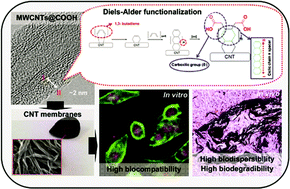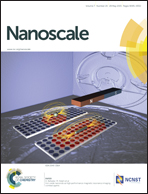Diels–Alder functionalized carbon nanotubes for bone tissue engineering: in vitro/in vivo biocompatibility and biodegradability†
Abstract
The risk-benefit balance for carbon nanotubes (CNTs) dictates their clinical fate. To take a step forward at this crossroad it is compulsory to modulate the CNT in vivo biocompatibility and biodegradability via e.g. chemical functionalization. CNT membranes were functionalised combining a Diels–Alder cycloaddition reaction to generate cyclohexene (–C6H10) followed by a mild oxidisation to yield carboxylic acid groups (–COOH). In vitro proliferation and osteogenic differentiation of human osteoblastic cells were maximized on functionalized CNT membranes (p,f-CNTs). The in vivo subcutaneously implanted materials showed a higher biological reactivity, thus inducing a slighter intense inflammatory response compared to non-functionalized CNT membranes (p-CNTs), but still showing a reduced cytotoxicity profile. Moreover, the in vivo biodegradation of CNTs was superior for p,f-CNT membranes, likely mediated by the oxidation-induced myeloperoxidase (MPO) in neutrophil and macrophage inflammatory milieus. This proves the biodegradability faculty of functionalized CNTs, which potentially avoids long-term tissue accumulation and triggering of acute toxicity. On the whole, the proposed Diels–Alder functionalization accounts for the improved CNT biological response in terms of the biocompatibility and biodegradability profiles. Therefore, CNTs can be considered for use in bone tissue engineering without notable toxicological threats.


 Please wait while we load your content...
Please wait while we load your content...